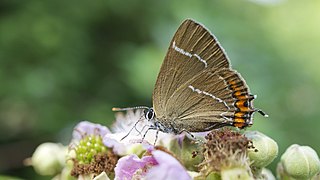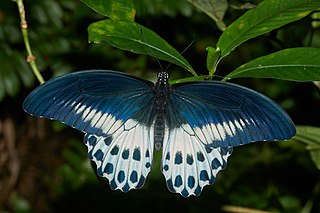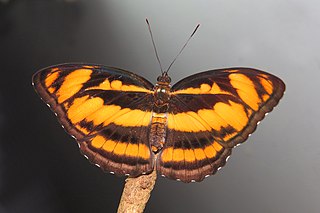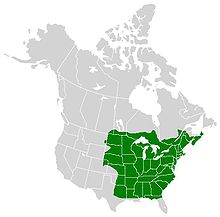
Polygonia c-album, the comma, is a food generalist (polyphagous) butterfly species belonging to the family Nymphalidae. The angular notches on the edges of the forewings are characteristic of the genus Polygonia, which is why species in the genus are commonly referred to as anglewing butterflies. Comma butterflies can be identified by their prominent orange and dark brown/black dorsal wings.

The brown hairstreak is a butterfly in the family Lycaenidae. The range includes most of the Palaearctic.

The purple hairstreak is a butterfly in the family Lycaenidae distributed throughout much of Europe, North Africa, Anatolia, Caucasia, and Transcaucasia. The larva feeds on Quercus robur, Quercus petraea, Quercus cerris and Quercus ilex.

The white-letter hairstreak is a butterfly in the family Lycaenidae.

Lycaena phlaeas, the small copper, American copper, or common copper, is a butterfly of the Lycaenids or gossamer-winged butterfly family. According to Guppy and Shepard (2001), its specific name phlaeas is said to be derived either from the Greek φλέγω (phlégo), "to burn up", or from the Latin floreo, "to flourish".

The Adonis blue is a butterfly in the family Lycaenidae. It inhabits the Palearctic realm.

Vanessa indica, called the Indian red admiral or the Asian admiral in the United States, is a butterfly found in the higher altitude regions of India, primarily the Himalayas and the Nilgiri Hills. It is also found in Sri Lanka and Myanmar, China, Korea, SE Russia, Japan. It is a close relative of the painted lady.

Acraea terpsicore, the tawny coster, is a small, 53–64 millimetres (2.1–2.5 in), leathery-winged butterfly common in grassland and scrub habitats. It belongs to the Nymphalidae or brush-footed butterfly family. It has a weak fluttery flight. It is avoided by most insect predators. This species and the yellow coster are the only two Indian representatives of the predominantly African tribe Acraeini. It is found in India, Sri Lanka, Maldives to Myanmar, Thailand, Laos, Cambodia, Vietnam, Bangladesh, Singapore, and recently Australia

Udaspes folus, the grass demon, is a small but prominent butterfly found in India & Nepal that belongs to the skippers family, Hesperiidae. It is regarded as an occasional pest of ginger and turmeric.

Matapa aria, the common redeye, is a butterfly belonging to the family Hesperiidae found in India and Southeast Asia.

Papilio polymnestor, the blue Mormon, is a large swallowtail butterfly found in south India and Sri Lanka. It is the "state butterfly" of the Indian state of Maharashtra. With a wingspan of 120–150 mm, it is the fourth largest butterfly of India.

Polygonia interrogationis, commonly called the question mark butterfly, is a North American nymphalid butterfly. It lives in wooded areas, city parks, generally in areas with a combination of trees and open space. The color and textured appearance of the underside of its wings combine to provide camouflage that resembles a dead leaf. The adult butterfly has a wingspan of 4.5–7.6 cm (1.8–3.0 in). Its flight period is from May to September. "The silver mark on the underside of the hindwing is broken into two parts, a curved line and a dot, creating a ?-shaped mark that gives the species its common name."

Athyma nefte, the colour sergeant, is a species of brush-footed butterfly found in tropical South and Southeast Asia.

Pantoporia hordonia, the common lascar, is a species of nymphalid butterfly found in Cambodia, tropical and subtropical Asia.

Libythea celtis, the European beak or nettle-tree butterfly, is a butterfly of the Libytheinae group of the brush-footed butterflies family.

Melitaea didyma, the spotted fritillary or red-band fritillary, is a butterfly of the family Nymphalidae.

Polygonia egea, the southern comma, is a butterfly of the family Nymphalidae. It is found in southern Europe.
Agathymus neumoegeni is commonly referred to as the orange giant-skipper, Neumogen's giant-skipper, Neumogen's agave borer, Neumogen's moth-skipper, and tawny giant-skipper.

Polygonia faunus, the green comma, Faunus comma, or Faunus anglewing is a butterfly of the family Nymphalidae.

Polygonia satyrus, the satyr comma, is a North American butterfly of the nymphalid family. It is primarily found in western Canada, where it is locally common. It bears a resemblance to Polygonia comma, the eastern comma, with which it is frequently confused. Its caterpillars feed on Urtica dioica - Stinging Nettle.






















